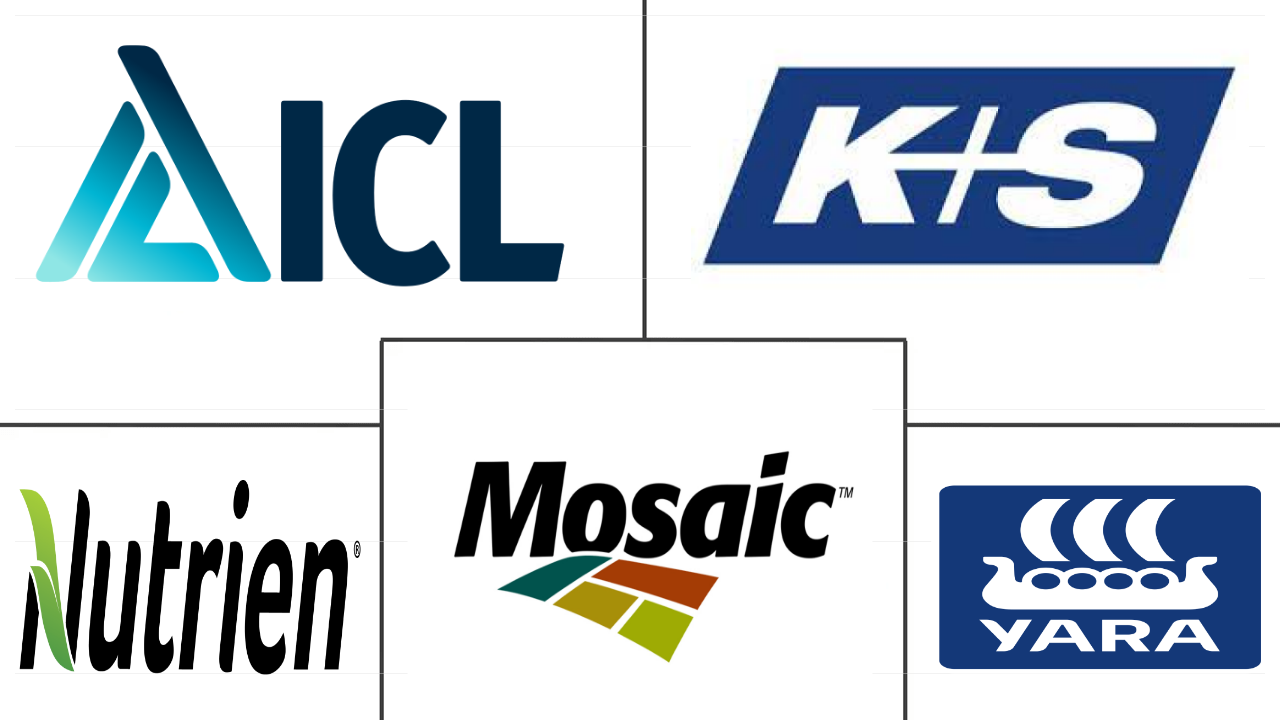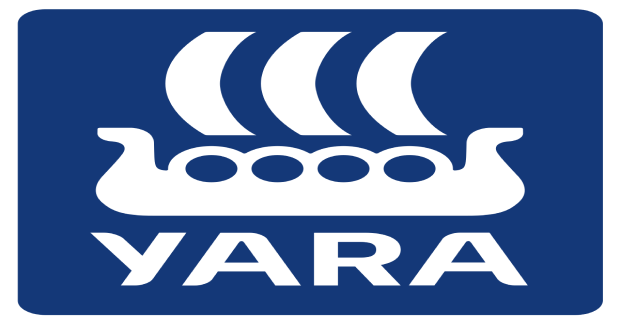Market Size of south america fertilizers Industry
|
|
Study Period | 2017 - 2030 |
|
|
Market Size (2024) | USD 49.35 Billion |
|
|
Market Size (2030) | USD 68.66 Billion |
|
|
Largest Share by Crop Type | Field Crops |
|
|
CAGR (2024 - 2030) | 5.66 % |
|
|
Largest Share by Country | Brazil |
Major Players |
||

|
||
|
*Disclaimer: Major Players sorted in no particular order |
South America Fertilizers Market Analysis
The South America Fertilizers Market size is estimated at 49.35 billion USD in 2024, and is expected to reach 68.66 billion USD by 2030, growing at a CAGR of 5.66% during the forecast period (2024-2030).
49.35 Billion
Market Size in 2024 (USD)
68.66 Billion
Market Size in 2030 (USD)
8.25 %
CAGR (2017-2023)
5.66 %
CAGR (2024-2030)
Largest segment by Product
30.41 %
value share, MoP, 2023
With a potassium content ranging from 60.0% to 62.0%, MoP boasts the highest concentration among potassic fertilizers, positioning itself as the most widely used in the region.
Largest Segment by Crop Type
94.63 %
value share, Field Crops, 2023
Due to intensive cultivation and monoculture practices, field crops have depleted the nutrients in the soil. Thus, leading to higher specialty fertilizer consumption.
Fastest Growing Speciality Type
7.16 %
Projected CAGR, CRF, 2024-2030
The factors such as providing sustained and efficient nutrient supply to the plants and fewer nutrient losses are driving the demand for control-release fertilizers.
Largest segment by Country
72.49 %
value share, Brazil, 2023
Brazil is expected to account for 70.0% of the world's arable land by the year 2050, and it is expected to be a major market for various fertilizers in the future.
Leading Market Player
15.77 %
market share, Yara International ASA, 2022

Yara International involves in production and marketing of crop nutrition products and solutions. Which includes foliar, water soluble, micronutrient and other fertilizers.
The fertilizer market is poised for growth due to shifting climate patterns and rising soil nutrient deficiencies
- The overall fertilizer market value by crop type has accounted for USD 48.1 billion and is estimated to record a CAGR of 5.6% during 2023-2030. By volume, the overall consumption accounted for 64.0 million metric tons and is estimated to record a CAGR of 3.3% during 2023-2030.
- By crop type, field crops are dominating the market by 94.5%, followed by horticultural crops with 5.5% of fertilizer consumption value. Both horticultural and field crops are essential to the country's trade and consumption, and the increased domestic and international demand is bolstering the segment's growth.
- The area under field crop cultivation has increased by a CAGR of 2.2% during 2023-2030. With important crops being cultivated in the country, such as soybean, corn, and wheat, the country is actively importing fertilizers to meet the domestic demand, which is driving the growth of the segments.
- Accordingly, Free trade agreements (FTAs) between the United States, Chile, and several Latin American countries have been a major factor in the increase in fruit and vegetable production in South American countries over the last few decades. These FTAs, including NAFTA (USMCA), CAFTA-DR, and bilateral agreements with countries such as Chile, Colombia, Panama, and Peru, are expected to further boost fertilizer demand in the region.
- The growth of the South American fertilizers market is being driven by various factors, including the need to meet the growing demand, improve crop yield and quality, and increase production. As a result, the market volume is expected to register a CAGR of 3.3% from 2023 to 2030.
Due to higher cultivation areas under major crops like soybeans, fertilizer consumption in Brazil leads to a higher share
- Brazil, accounting for 73.0% of South America's domestic fertilizer consumption, leads the region in fertilizer usage. The Brazilian market is predominantly driven by conventional fertilizers, which held a commanding 95.2% share in 2022. Specialty fertilizers made up the remaining 4.8%.
- Argentina, a global exporter of wheat and soybeans, sees agriculture contributing around 5.9% to its GDP. In 2022, Argentina held a 14.6% share of the South American fertilizer market. Similar to Brazil, conventional fertilizers dominated, capturing 96.1% of the market, while specialty fertilizers accounted for 3.9%. Within the specialty segment, liquid fertilizers led at 44.7%, followed by water-soluble fertilizers at 52.6%.
- The Rest of South America, excluding Brazil and Argentina, held a 14.8% share of the regional fertilizer market in 2022. Field crops, commanding an 83.1% market share by volume, reached 8.15 million metric tons in 2022. Projections indicate this volume will climb to 10.53 million metric tons by 2030, representing a significant growth trajectory.
- Field crops, including soybeans, corn, and sugarcane, dominated the South American fertilizer market in 2022, capturing 94.2% of the market share. These crops have witnessed substantial growth over the past two decades, with further increases expected. Driven by countries like Brazil expanding their cultivated areas and aiming for higher yields, this trend is set to continue.
- Driven by a rising population and the subsequent surge in food grain demand, South America has witnessed a consistent expansion in the area dedicated to major food crops. This trend points to a projected growth in the region's fertilizer market during 2023-2030.
South America Fertilizers Industry Segmentation
Complex, Straight are covered as segments by Type. Conventional, Speciality are covered as segments by Form. Fertigation, Foliar, Soil are covered as segments by Application Mode. Field Crops, Horticultural Crops, Turf & Ornamental are covered as segments by Crop Type. Argentina, Brazil are covered as segments by Country.
- The overall fertilizer market value by crop type has accounted for USD 48.1 billion and is estimated to record a CAGR of 5.6% during 2023-2030. By volume, the overall consumption accounted for 64.0 million metric tons and is estimated to record a CAGR of 3.3% during 2023-2030.
- By crop type, field crops are dominating the market by 94.5%, followed by horticultural crops with 5.5% of fertilizer consumption value. Both horticultural and field crops are essential to the country's trade and consumption, and the increased domestic and international demand is bolstering the segment's growth.
- The area under field crop cultivation has increased by a CAGR of 2.2% during 2023-2030. With important crops being cultivated in the country, such as soybean, corn, and wheat, the country is actively importing fertilizers to meet the domestic demand, which is driving the growth of the segments.
- Accordingly, Free trade agreements (FTAs) between the United States, Chile, and several Latin American countries have been a major factor in the increase in fruit and vegetable production in South American countries over the last few decades. These FTAs, including NAFTA (USMCA), CAFTA-DR, and bilateral agreements with countries such as Chile, Colombia, Panama, and Peru, are expected to further boost fertilizer demand in the region.
- The growth of the South American fertilizers market is being driven by various factors, including the need to meet the growing demand, improve crop yield and quality, and increase production. As a result, the market volume is expected to register a CAGR of 3.3% from 2023 to 2030.
| Type | |||||||||||||||||||||||||||||||||
| Complex | |||||||||||||||||||||||||||||||||
|
| Form | ||||||
| Conventional | ||||||
|
| Application Mode | |
| Fertigation | |
| Foliar | |
| Soil |
| Crop Type | |
| Field Crops | |
| Horticultural Crops | |
| Turf & Ornamental |
| Country | |
| Argentina | |
| Brazil | |
| Rest of South America |
South America Fertilizers Market Size Summary
The South America Fertilizers Market is poised for significant growth, driven by the increasing demand for agricultural production to meet the needs of a rising population. The market is characterized by a strong focus on field crops, which dominate the fertilizer consumption landscape, with soybeans, corn, and wheat being the primary crops driving this demand. The expansion of cultivated areas, particularly in Brazil and Argentina, is a key factor contributing to the market's growth trajectory. The region's strategic trade agreements, such as those with the United States and various Latin American countries, have further bolstered the production of fruits and vegetables, thereby enhancing the demand for fertilizers. The market is also witnessing a shift towards conventional fertilizers, with specialty fertilizers gaining traction, particularly in Argentina.
The South American fertilizers market is fragmented, with major players like ICL Group Ltd, K+S Aktiengesellschaft, Nutrien Ltd., The Mosaic Company, and Yara International ASA holding significant shares. These companies are actively expanding their operations and product offerings to cater to the growing demand. The market's growth is underpinned by the need to improve crop yield and quality, as well as the increasing area under field crop cultivation. The application of primary nutrients such as nitrogen, phosphorus, and potassium is crucial for enhancing crop output, and their usage is expected to rise in tandem with the expanding agricultural areas. Despite challenges such as drought conditions affecting crop harvests and transportation, the overall outlook for the South American fertilizers market remains positive, with a steady increase in both market size and consumption volume anticipated over the forecast period.
South America Fertilizers Market Size - Table of Contents
-
1. MARKET SEGMENTATION (includes market size in Value in USD and Volume, Forecasts up to 2030 and analysis of growth prospects)
-
1.1 Type
-
1.1.1 Complex
-
1.1.2 Straight
-
1.1.2.1 Micronutrients
-
1.1.2.1.1 Boron
-
1.1.2.1.2 Copper
-
1.1.2.1.3 Iron
-
1.1.2.1.4 Manganese
-
1.1.2.1.5 Molybdenum
-
1.1.2.1.6 Zinc
-
1.1.2.1.7 Others
-
-
1.1.2.2 Nitrogenous
-
1.1.2.2.1 Ammonium Nitrate
-
1.1.2.2.2 Urea
-
1.1.2.2.3 Others
-
-
1.1.2.3 Phosphatic
-
1.1.2.3.1 DAP
-
1.1.2.3.2 MAP
-
1.1.2.3.3 SSP
-
1.1.2.3.4 TSP
-
1.1.2.3.5 Others
-
-
1.1.2.4 Potassic
-
1.1.2.4.1 MoP
-
1.1.2.4.2 SoP
-
1.1.2.4.3 Others
-
-
1.1.2.5 Secondary Macronutrients
-
1.1.2.5.1 Calcium
-
1.1.2.5.2 Magnesium
-
1.1.2.5.3 Sulfur
-
-
-
-
1.2 Form
-
1.2.1 Conventional
-
1.2.2 Speciality
-
1.2.2.1 CRF
-
1.2.2.2 Liquid Fertilizer
-
1.2.2.3 SRF
-
1.2.2.4 Water Soluble
-
-
-
1.3 Application Mode
-
1.3.1 Fertigation
-
1.3.2 Foliar
-
1.3.3 Soil
-
-
1.4 Crop Type
-
1.4.1 Field Crops
-
1.4.2 Horticultural Crops
-
1.4.3 Turf & Ornamental
-
-
1.5 Country
-
1.5.1 Argentina
-
1.5.2 Brazil
-
1.5.3 Rest of South America
-
-
South America Fertilizers Market Size FAQs
How big is the South America Fertilizers Market?
The South America Fertilizers Market size is expected to reach USD 49.35 billion in 2024 and grow at a CAGR of 5.66% to reach USD 68.66 billion by 2030.
What is the current South America Fertilizers Market size?
In 2024, the South America Fertilizers Market size is expected to reach USD 49.35 billion.

